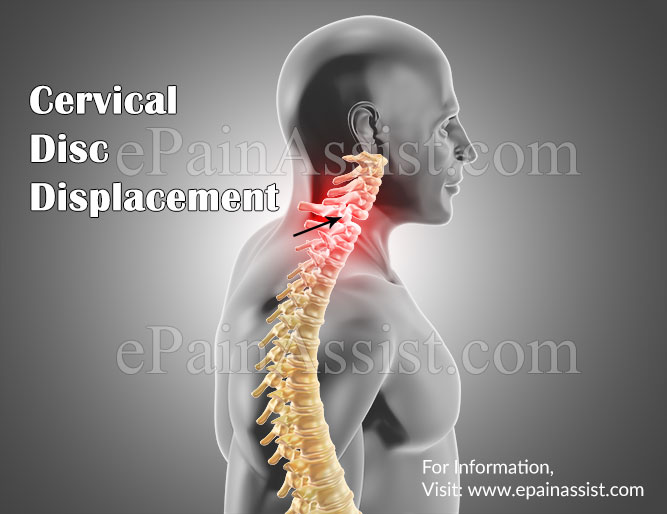What is Cervical Disc Displacement?
Cervical Disc Displacement is a pathological condition of the cervical spine in which one of the discs which forms the cervical spine moves out of its normal alignment. These discs act as a tool which reduces the stress on the cervical spine from everyday chores that an individual does and keeps the cervical vertebrae separated from each other.
In cases of Cervical Disc Displacement, the disc is no longer able to provide the cushioning to the bones of the cervical vertebra and thus even performing daily tasks becomes difficult for an individual. Cervical Disc Displacement leads to chronic neck pain and if not treated appropriately may lead to pain which may radiate to other parts of the upper extremity and using the hands for doing everyday work may become difficult due to the pain as a result of Cervical Disc Displacement.

What Causes Cervical Disc Displacement?
In majority of the cases, Cervical Disc Displacement occurs due to the natural process of aging with degeneration of the cervical spine. With age, the water content in the cervical discs gets reduced making the disc weak. This is medically termed as disc degeneration. Apart from disc degeneration, there are also various factors that may cause a Cervical Disc Displacement.
Gender is one of the factors and it is seen that males between the age of 35 and 50 are more prone to have Cervical Disc Displacement than females in the same age group. People who have a bad sitting posture and flex their neck for prolonged period of times when sitting in front of the computer or otherwise are also at risk for Cervical Disc Displacement.
All these things put a lot of strain on the discs of the cervical spine which eventually starts degenerating and ultimately moves out of alignment causing Cervical Disc Displacement.
What are the Symptoms of Cervical Disc Displacement?
Some of the symptoms of Cervical Disc Displacement are:
- Excruciating chronic neck pain
- Pain radiating to the shoulders down the hand and forearms can be a symptom of cervical disc displacement
- Numbness or tingling in the shoulders, elbows, forearms, and fingers.
How is Cervical Disc Displacement Diagnosed?
In order to diagnose Cervical Disc Displacement, the physician will first perform a detailed physical examination to inspect the area of concern which is the neck. The physician will look for areas of tenderness around the cervical spine. He or she may also test the range of motion of the neck to look whether it causes pain with movement. If the patient experiences pain with movement which radiates to the shoulders then it may point towards a Cervical Disc Displacement. For further investigation, radiological studies will be performed with an x-ray of the cervical spine along with advanced imaging like MRI and CT scan. These studies will clearly delineate and confirm the diagnosis of Cervical Disc Displacement.
Treatment of Cervical Disc Displacement
Cervical Disc Displacement may be treated both conservatively as well as surgically, although surgical procedures are reserved only if all conservative measures to treat the condition fail. To begin with, the patient will be asked to refrain from activity that may aggravate the symptoms, rest for a period of time, and antiinflammatory medications and NSAIDs in the form of Tylenol or ibuprofen to calm down the inflammation may be prescribed.
Minor cases of Cervical Disc Displacement can be effectively treated by these measures along with spine specific physical therapy. In most of the cases, these measures are enough to successfully treat cervical disc displacement and allow the patient to lead a normal life in a few months. In some cases, if significant relief is not obtained by these measures, then steroid injections are recommended for pain relief.
Controlled use of narcotics is also one way to treat pain due to cervical disc displacement but this is only for a short period of time. Additionally, the patient will also be advised lifestyle modifications to include a good sitting posture and certain neck exercises.
In case if all these measures fail to provide relief to the patient then surgery is recommended for treatment of cervical disc displacement. The surgical procedures done for treatment of cervical disc displacement are:
Anterior Cervical Discectomy and Fusion (ACDF): This surgical procedure for cervical disc displacement involves excision of the displaced disc by making an incision just in front of the neck. After successfully removing the disc, the disc space is fused.
Posterior Cervical Discectomy: This surgical procedure is used for laterally displaced cervical discs. This method is far more complex than an anterior approach and may result in excessive bleeding due to the number of veins and arteries that the surgeon has to maneuver while taking this approach to treat cervical disc displacement.
Artificial Cervical Disc Replacement: This surgical procedure is similar to ACDF with just the difference being that after excision of the displaced disc an artificial disc is replaced in proper alignment to treat cervical disc displacement.
